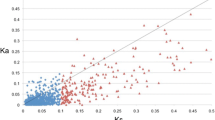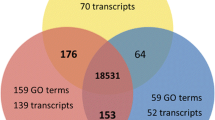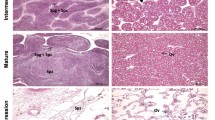Abstract
Modern pyrosequencing has the potential to uncover many interesting aspects of genome evolution, even in lineages where genomic resources are scarce. In particular, 454 pyrosequencing of nonmodel species has been used to characterize expressed sequence tags, xenobiotics, gene ontologies, and relative levels of gene expression. Herein, we use pyrosequencing to study the evolution of genes expressed in the gonads of a polyploid fish, the lake sturgeon (Acipenser fulvescens). Using 454 pyrosequencing of transcribed genes, we produced more than 125 MB of sequence data from 473,577 high-quality sequencing reads. Sequences that passed stringent quality control thresholds were assembled into 12,791 male contigs and 32,629 female contigs. Average depth of coverage was 4.2 × for the male assembly and 5.5× for the female assembly. Analytical rarefaction indicates that our assemblies include most of the genes expressed in lake sturgeon gonads. Over 86,700 sequencing reads were assigned gene ontologies, many to general housekeeping genes like protein, RNA, and ion binding genes. We searched specifically for sex determining genes and documented significant sex differences in the expression of two genes involved in animal sex determination, DMRT1 and TRA-1. DMRT1 is the master sex determining gene in birds and in medaka (Oryzias latipes) whereas TRA-1 helps direct sexual differentiation in nematodes. We also searched the lake sturgeon assembly for evidence of xenobiotic organisms that may exist as endosymbionts. Our results suggest that exogenous parasites (trematodes) and pathogens (protozoans) apparently have infected lake sturgeon gonads, and the trematodes have horizontally transferred some genes to the lake sturgeon genome.






Similar content being viewed by others

Abbreviations
- SNP:
-
Single nucleotide polymorphism
References
Alam MA, Kobayashi Y, Horiguchi R et al (2008) Molecular cloning and quantitative expression of sexually dimporhic markers Dmrt1 and Foxl2 during female-to-male sex change in Epinephelus merra. Gen Comp Endocrinol 157:75–85
Ashburner MC, Ball JA, Blake A et al (2000) Gene ontology: tool for the unification of biology. Nat Genet 25:25–29
Avise JC, Mank JE (2010) Evolutionary perspectives on hermaphroditism in fishes. Sex Dev, in press
Barbazuk WB, Emrich SJ, Chen HD et al (2007) SNP discovery via 454 transcriptome sequencing. Plant Journal 51:910–918
Blacklidge KH, Bidwell CA (1993) Three ploidy levels indicated by genome quantification in Acipenseriformes of North America. J Hered 84:427–430
Bruch RM, Dick TA, Choudhury A (2001) A field guide for the identification of stages of gonad development in lake sturgeon (Acipenser fulvescens Rafinesque) with notes on lake sturgeon reproductive biology and management implications. Sturgeon for Tomorrow, Fond du Lac, WI
Cheung F, Haas BJ, Goldberg SMD et al (2006) Sequencing Medicago truncatula expressed sequenced tags using 454 life sciences technology. BMC Genomics 7:272
Cheung F, Win J, Lang JM et al (2008) Analysis of the Pythium ultimum transcriptome using Sanger and Pyrosequencing approaches. BMC Genomics 9:542
Colombo RE, Garvey JE, Wills PS (2007) A guide to the embryonic development of the shovelnose sturgeon (Scaphirhynchus platorynchus), reared at a constant temperature. J Appl Ichthyol 23:402–410
Deagle BE, Kirkwood R, Jarman SN (2009) Analysis of Australian fur seal diet by Pyrosequencing prey DNA in faeces. Mol Ecol 18:2022–2038
Devlin RH, Nagahama Y (2002) Sex determination and sex differentiation in fish: an overview of genetic, physiological, and environmental influences. Aquaculture 208:191–364
DeWoody JA, Hale MC, Avise JC (2010) Vertebrate sex determining genes and their potential utility in conservation, with particular emphasis on fishes. In: DeWoody JA, Bickham JW, Michler C, Nichols K, Rhodes OE, Woeste K (eds). Molecular approaches in natural resource conservation. Cambridge University Press (in press)
Ferguson-Smith M (2007) The evolution of sex chromosomes and sex determination in vertebrates and the key role of DMRT1. Sex Dev 1:2–11
Gotelli NJ, Ensminger GL (1997) EcoSim: null models software for ecologists. Bull Ecol Soc Am 78:96
Hale MC, McCormick CR, Jackson CR, DeWoody JA (2009) Next-generation pyrosequencing of gonad transcriptomes in the polyploid lake sturgeon (Acipenser fulvescens): the relative merits of normalization and rarefaction in gene discovery. BMC Genomics 10:203. doi:10.1186/1471-2164-10-203
He YX, Salafsky B, Ramaswamy K (2001) Host-parasite relationships of Schistosoma japonicum in mammalian hosts. Trends Parasitol 17:320–324
Hett AK, Ludwig A (2005) SRY-related (Sox) genes in the genome of European Atlantic sturgeon (Acipenser sturio). Genome 48:181–186
Huang XQ, Wang JM, Aluru S et al (2003) PCAP: A whole-genome assembly program. Genome Res 13:2164–2170
Huang X, Hong CS, O’Donnell M et al (2005) The doublesex-related gene XDmrt4, is required for neurogenesis in the olfactory system. Proc Natl Acad Sci USA 102:11349–11354
Hudson ME (2008) Sequencing breakthroughs for genomic ecology and evolutionary biology. Mol Ecol Resour 8:3–17
Huse SM, Huber JA, Morrison HG et al (2007) Accuracy and quality of massively parallel DNA pyrosequencing. Genome Biol 8:R143
Jackson JR, VanDeValk AJ, Brooking TE et al (2002) Growth and feeding dynamics of lake sturgeon, Acipenser fulvescens, in Oneida Lake, New York: results from the first five years of a restoration program. J Appl Ichthyol 18:439–443
Keyvanshokooh S, Pourkazemi M, Kalbassi MR (2007) The RAPD technique failed to identify sex-specific sequences in beluga (Huso huso). J Appl Ichthyol 23:1–2
Kohler SL, Hoiland WK (2001) Population regulation in an aquatic insect: the role of disease. Ecology 82:2294–2305
Kondo M, Nanda I, Hornung U et al (2004) Evolutionary origin of the medaka Y chromosome. Curr Biol 14:1664–1669
Ludwig A, Belfiore NM, Pitra C et al (2001) Genome duplication events and functional reduction of ploidy levels in sturgeon (Acipenser, Huso and Scaphirhynchus). Genetics 158:1203–1215
Margulies MM, Egholm W, Altman E et al (2005) Genome sequencing in microfabricated high-density pico litre reactors. Nature 437:376–380
Matsuda M, Nagahama Y, Schinomiya A et al (2002) DMT is a Y-specific DM-domain gene required for male development in the medaka fish. Nature 417:559–563
Matveev V, Okada N (2009) Retroposons of salmonid fishes (Actinopterygii: Salmonoidei) and their evolution. Gene 434:16–28
McCormick CR, Bos DH, DeWoody JA (2008) Multiple molecular approaches yield no evidence for sex-determining genes in lake sturgeon (Acipenser fulvescens). J Appl Ichthyol 24:643–645
Melamed P, Chong KL, Johansen MV (2004) Evidence for lateral gene transfer from salmonids to two Schistosome species. Nat Genet 36:786–787
Miller W, Drautz DI, Ratan A et al (2008) Sequencing the nuclear genome of the extinct woolly mammoth. Nature 456:380–387
Moore MJ, Dhingra A, Soltis PS et al (2006) Rapid and accurate Pyrosequencing of angiosperm plastid genomes. BMC Plant Biology 6:17
Nanda I, Kondo M, Hornung U et al (2002) A duplicated copy of DMRT1 in the sex determining region of the Y chromosome of the medaka, Oryzias latipes. Proc Natl Acad Sci USA 99:11778–11783
Noakes DLG, Beamish FWH, Rossiter A (1999) Conservation implications of behaviour and growth of the lake sturgeon, Acipenser fulvescens, in northern Ontario. Environ Biol Fishes 55:135–144
Novaes ED, Drost R, Farmerie WG et al (2008) High-throughput gene and SNP discovery in Eucalyptus grandis, an uncharacterized genome. BMC Genomics 9:312
Peterson DL, Vecsei P, Jennings CA (2007) Ecology and biology of the lake sturgeon: a synthesis of current knowledge of a threatened North American Acipenseridae. Rev Fish Biol Fish 17:59–76
Schwebke JR, Burgess D (2004) Trichomoniasis. Clin Microbiol Rev 17:794–803
Shaw DR, Ashburner M, Blake JA et al (1999) Gene Ontology: a controlled vocabulary to describe the function, biological process and cellular location of gene products in genome databases. Am J Hum Genet 65:1419
Sinclair AH, Berta P, Palmer MS et al (1990) A gene from the human sex-determining region encodes a protein with homology to a conserved DNA-binding motif. Nature 346:240–244
Smith CA, Roeszler KN, Ohnesirg T et al (2009) The avian Z-linked gene DMRT1 is required for male sex determination in chicken. Nature 461:267–271
Torres TT, Metta M, Ottenwalder B, Schlotterer C (2008) Gene expression profiling by massively parallel sequencing. Genome Res 18:172–177
Van Eenennaam AL, Van Eenennaam JP, Medrano JF et al (1999) Evidence of female heterogametic genetic sex determination in white sturgeon. J Hered 90:231–233
Vera JC, Wheat CW, Fescemyer HW et al (2008) Rapid transcriptome characterization for a nonmodel organism using 454 pyrosequencing. Mol Ecol 17:1636–1647
Weber APM, Weber KL, Carr K et al (2007) Sampling the Arabidopsis transcriptome with massively parallel pyrosequencing. Plant Physiol 144:32–42
Wicker T, Schlagenhauf E, Graner A et al (2006) 454 sequencing put to the test using the complex genome of barley. BMC Genomics 7:275
Wuertz S, Gaillard S, Barbisan F et al (2006) Extensive screening of sturgeon genomes by random screening techniques revealed no sex-specific marker. Aquaculture 258:685–688
Zhu YY, Machleder EM, Chenchik A et al (2001) Reverse transcriptase template switching: A SMART (TM) approach for full-length cDNA library construction. Biotechniques 30:892–897
Acknowledgments
We thank P. San Miguel and P. Parker for their help with sequencing of the cDNA. We are grateful for helpful comments from the DeWoody lab group and from A. Chin-Baarstad, G. Dharmarajan, S. Edwards, B. Hecht, and K. Nichols. In addition, we are indebted to M. Ducore for his help with PCR validation. This work was funded by grants to JAD from the Great Lakes Fishery Trust and the Indiana Department of Natural Resources through a State Wildlife Grant (T07R05).
Author information
Authors and Affiliations
Corresponding author
Electronic supplementary material
Below is the link to the electronic supplementary material.
Rights and permissions
About this article
Cite this article
Hale, M.C., Jackson, J.R. & DeWoody, J.A. Discovery and evaluation of candidate sex-determining genes and xenobiotics in the gonads of lake sturgeon (Acipenser fulvescens). Genetica 138, 745–756 (2010). https://doi.org/10.1007/s10709-010-9455-y
Received:
Accepted:
Published:
Issue Date:
DOI: https://doi.org/10.1007/s10709-010-9455-y



